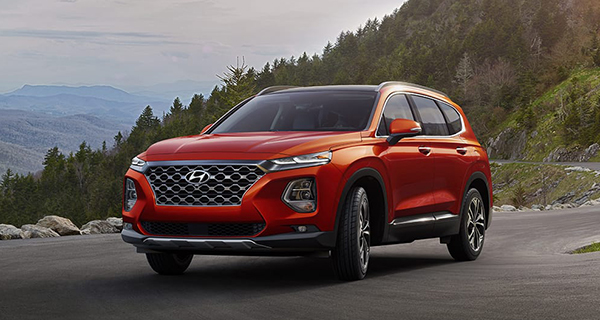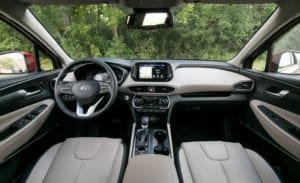
The 2019 Hyundai Santa Fe does exactly what it’s supposed to: provide comfortable, driver-friendly transport, with a reasonable (depending on the model and trim level) price tag.
 Although it sometimes seems that every other vehicle on the road is a Hyundai Santa Fe, this mid-size SUV from Korea is actually not even in the best-selling top 10.
Although it sometimes seems that every other vehicle on the road is a Hyundai Santa Fe, this mid-size SUV from Korea is actually not even in the best-selling top 10.
The best-selling SUVs in Canada are the likes of the Ford Escape, Honda CR-V and Toyota RAV4. According to the people who monitor these things, Hyundai’s Tucson outsells the Santa Fe by a significant amount.
Nonetheless, the Santa Fe is a popular vehicle in Canada and for 2019, has three engine choices: 3.3-litre V6 (XL version), 2.4-litre normally-aspirated four cylinder, and 2.0 turbocharged four cylinder.
I drove the latter, with the Ultimate trim level. This is the top-of-the-line version of the four-cylinder model and my tester had all-wheel drive and an eight-speed automatic gearbox with manual shift option. This transmission is the only choice, incidentally, and is utilized across the model range. It’s a major point in the Santa Fe’s favour, as far as I’m concerned.
Power output for the turbo four is 235 horsepower, which makes the 2019 Santa Fe a reasonably lively vehicle with a nice – albeit brief – well of reserve power. Love that turbo boost. And fuel economy isn’t bad, but not outstanding, at 11.2 litres/100 km combined rating.
This version also has Hyundai’s idle stop feature, which cuts power at stoplights. Some manufacturers do this better than others and Hyundai’s treatment is a little less refined compared to others I’ve experienced. There is just a nano-second of delay between the time you take your foot off the brake pedal and the time the engine cuts back in. Not necessarily a deal-breaker but kind of annoying after a while.

The standard equipment level in the 2019 Hyundai Santa Fe is high, with things like heated seats, hill-start assist, Bluetooth,trailer pre-wiring, electronic parking brake, steering wheel-mounted controls, etc., coming with all versions.
Interior elbow room, kind of key in this market, is put at 2,019 litres, which is somewhere in the middle of the pack. Lowering the second row seats is easily accomplished and access is reasonably straightforward.
In fact, if I had to apply a word to the Santa Fe, it would be ‘straightforward.’ There’s nothing about this vehicle that would compel you to do cartwheels or jump up and down with excitement.
On the other hand, it does exactly what it’s supposed to: provide comfortable, driver-friendly transport, with a reasonable (depending on the model and trim level) price tag.
This is how Hyundai has managed to break into this market dominated by Japanese and domestic manufacturers. They’ve taken a page from the likes of Honda and Toyota when it comes to giving customers good value: standard equipment level is high, with things like heated seats, hill-start assist, Bluetooth, trailer pre-wiring, electronic parking brake, steering wheel-mounted controls, etc., etc., coming with all versions.
In every sense, the Santa Fe is right where it needs to be in this hotly-contested market.
That said, the Ultimate I drove will run you $45,000 before taxes and levies, which is a little on the high side. The base front-wheel-drive version with the non-turbo 2.4-litre engine, with a base price tag of just under $30,000, represents a much better deal. It has many of the same features as the Ultimate – but no leather interior or glitzy driver-vehicle interface. And it accomplishes exactly the same thing, but with a much more accessible price. My advice is to have a long, hard look at the base model.
One other small thing: The engine/drivetrain is not as well behaved or sophisticated as some of its Japanese rivals. The engine, for example, is louder and more clunky than that of the Honda CR-V or Toyota RAV4 and borders on obtrusive.
On the other hand, I found wind and highway noise on the highway to be much less than that of the CR-V. The Santa Fe seems to be well screwed together, if a little less refined.
But its appeal is quite straightforward: high standard equipment level, driver-friendliness and a high degree of usability.
The Santa Fe is not a world beater, but it does the job and definitely holds its own in this market.
Maybe that’s why so many people drive it.
2019 Hyundai Santa Fe
Engine: 2.0-litre turbocharged four cylinder
Transmission: Eight-speed automatic
Drive: All-wheel drive
Horsepower: 235 horsepower at 6,000 rpm
Torque: 260 foot pounds at 1,450 to 3,500 rpm
Base price: $44,999
Fuel economy: 12.3 litres/100 km city and 9.8 highway, with regular gas
Some alternatives: Toyota RAV4, Honda CR-V, Ford Escape, Nissan Rogue, Mazda CX5, Kia Sorento, Volkswagen Tiguan, Chevrolet Equinox.
Ted Laturnus writes for Troy Media’s Driver Seat Associate website. An automotive journalist since 1976, he has been named Canadian Automotive Journalist of the Year twice and is past-president of the Automotive Journalists Association of Canada (AJAC).
The views, opinions and positions expressed by columnists and contributors are the author’s alone. They do not inherently or expressly reflect the views, opinions and/or positions of our publication.

